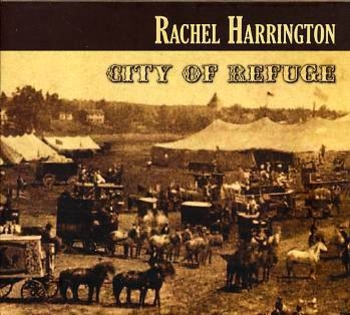Recent visitors here will have noticed that, once again, the songs are not playing. Once, again, my apologies to all. This time, I am going to do something about it. I am going to move to a new hosting service. This will entail moving all of the old files that I still want you to be able to hear to the new host. So this is going to take some time.
In the mean time, I am working on some things that will provide new content here, although not new songs as yet. I hope you will enjoy what I have planned.
I am also going to use this time to give Oliver di Place a facelift. So it may look different the next time you visit. Once it’s done, let me know what you think of the new look. And I will be adding some new functions that I hope will make your visit more enjoyable.
I would like to thank everyone for stopping by, and for your support.
Sunday, May 17, 2009
An Announcement
Posted by Darius at 2:01 AM 2 comments
Sunday, May 10, 2009
Rachel Harrington - City of Refuge

[purchase]
Rachel Harrington sings in a beautiful clean soprano voice. She plays guitar and guitjo, and her band includes mandolin, dobro, upright bass, and the wonderful Tim O’Brien on fiddle. I never heard of a guitjo either, but it must be the one that sounds like a banjo. So this must be a bluegrass album, right? Well, no. This is acoustic music, a mix of mostly original material with two traditional tunes and one cover. The band performs as an ensemble, with the bass sometimes helping with a melodic line, and the core band is joined by occasional pedal steel and a clarinet on one tune. Most songs are mid-tempo ballads, with two waltzes mixed in. So call this folk music, if you must have a label, but just make sure you listen.
Tim O’Brien is a very talented fiddler, and he is in high demand on the folk circuit. His presence here is no accident; there is a high level of musicianship on display. Listen to the opening riff in Karen Kane; before the song is over, you are going to hear it played, with variations, by every instrument in the band except the bass. It’s almost like listening to Bach.
Elsewhere, you will hear songs with very few words; Harrington lets the music carry the emotion in quite a few places. It never feels like a slight song has been stretched; the words say all that they must, and the band says the rest. Indeed, Harrington is not one to waste words. Under the Big Top, which closes the album, has only three lines of lyrics, sung twice. And yet, the song makes a strong statement, and it has the longest running time on the album.
It’s certainly true that some, and probably all, of these songs have different protagonists. And yet, City of Refuge, taken as a whole, tells a story. First, we meet two women who seek to break away from their circumstances. There is a statement of faith that something better can be built here on earth. Then the song Truman tells of a man who would not leave his home on Mt St. Helens because it held the memories of his dear departed wife; in the end, he is a ghost still riding on the mountain in his pink Cadillac. Carver is based on the works of Raymond Carver, and is a somewhat ambiguous declaration of love. The next two songs have sparse lyrics, and hint at death to come.
And then there is Ode To Billy Joe. Yes, this is the cover I mentioned earlier. This song has been the subject of great speculation. There are many details missing in the telling of the story. And Harrington chooses to drop two verses. She leaves out the middle verse about the brother. And she drops the final verse, which takes stock of the situation a year later. So the original story is now distilled. And the song, with all its mysteries, becomes the thematic center of the album. For Harrington, there is love, and the risk that goes with it, and there is loss, in the form of death. The details take a variety of forms in these songs, but the process of working through it is what interests her. And that comes through very clearly.
There are two more songs to close the album. There is a reaffirmation of faith, but this time it is faith in a better life in the hereafter. And finally, there is Under the Big Top, which comes across in context as an elegy for the departed.
So this is by no means a feel good album. But it is also not the downer that I may have made it sound like. The album as a whole is a remarkable piece of storytelling, and it leaves the listener feeling the comfort that can come from just the right person in times of stress. Rachel Harrington is that person here.
Rachel Harrington: Karen Kane
Rachel Harrington: Ode to Billy Joe
Posted by Darius at 3:59 AM 2 comments
Labels: Album Review, Rachel Harrington
Friday, May 8, 2009
For a Song: Edith and the Kingpin

Joni Mitchell: Edith and the Kingpin
[purchase]
Edith and the Kingpin comes from my favorite Joni Mitchell album, The Hissing of Summer Lawns. This puts me in a distinct minority. Mitchell achieved the height of her success with her previous album, Court and Spark. But the release of Summer Lawns cost her almost all of her newest fans, as well as many who had supported for years.
It has been said that the problem was Joni Mitchell’s exploration of jazz, but that actually began with Court and Spark. The band on the two albums is almost the same, and the sound is not that much of a leap either. So, what happened?
Mitchell basically invented the confessional singer-songwriter genre. There was almost no need to ever ask how her love life was; just listen to the newest songs. And no one has ever done it better. But finally, Mitchell grew tired of baring her soul in public. She began to crave privacy. And so, she did the unthinkable: she wrote an entire album of songs in the third person. And that was The Hissing of Summer Lawns. Her fans, new and old, were horrified.
What these fans missed was the fact that Mitchell had now revealed another facet of her talent: she is an amazing storyteller. At this point in her career, no one had seen many of her paintings. But the new songs revealed a great visual sense, in addition to a great feel for her characters.
Edith and the Kingpin presents the character of Edith, the new girl in the court of The Kingpin, who has no other name. We learn of Edith’s hopes and fears in this situation, while she deals with the discouraging words of a Greek chorus of “passed over girls”. But Mitchell also takes the time to consider the feelings of The Kingpin himself. “What does that hand desire, that he grips it so tight?” This image of one hand tightly gripping the other in a struggle for control that I see in my head whenever I think of this song.
For the rest of her career, Mitchell has displayed her gifts as a storyteller again and again. Her tales remain highly visual, and highly empathetic. And, while there were glimmers of it in her earlier work, the career of Joni Mitchell, storyteller, really got underway in earnest here.
Posted by Darius at 2:57 AM 3 comments
Labels: For a Song, Joni Mitchell
Wednesday, May 6, 2009
Ray Bonneville - Goin’ By Feel

[purchase]
Goin’ By Feel is a good name for this album. The playing, the arrangements, and the songwriting are all about feel, in different ways.
Ray Bonneville has a great feel for a groove. He plays his guitar with some light reverb, but otherwise with minimal effects, and his style is percussive. The drums and bass that appear on most tracks provide accents, and enhance the groove. but the guitar is mixed front and center. This is not dance music, however. This groove is a heartbeat, a pulse that provides motion.
Bonneville’s voice is a baritone with some grit. There is dust gently blowing down a country track in this voice, or spatters of light rain falling on a cheek. Like his guitar playing, Bonneville’s voice does not batter you with emotion; the effect is subtle. The emotions are carried by the words, and occasionally enhanced by Bonneville’s harmonica.
About those words; on first listen to them, I found this album very frustrating. Each song would start a story, but never finish it. I wanted to know what happened next. What Katy Did was especially aggravating; we never do find out what Katy did, but there are tantalizing clues.
But then I began to realize what Bonneville was up to. What Katy Did is not about Katy; it’s about a man who learned her secret, promised not to tell it, and is finding his promise hard to keep. The song is not a story at all; it’s about a character’s state of mind at a particular moment in time. And that is what this album is, a collection of moments. So Carry the Fallen describes a woman’s feelings on seeing the flag draped coffins returning from the war, and knowing that this is a sight her government didn’t mean for her to see. Sabine River describes a chance meeting between a man and woman traveling to New Orleans, at that moment when the meeting of two people is fraught with fears and full of possibilities. Cemetery Road describes the feelings of a woman as she walks by the cemetery where a loved one is buried; the nature of the relationship and the cause of death are never completely clear. Most unusually, I Am The Big Easy finds the city of New Orleans personified, contemplating its sense of identity in light of recent events; this is a concept that could have fallen flat on its face, but Bonneville makes it work.
So the words describe strong feelings and emotional conflicts. The singing and playing never force these emotions upon the listener. And the feelings are exposed by the lack of narrative; I haven’t encountered this type of songwriting very often, but in the end it works quite well. I am tempted to want an author to write a collection of short stories filling in all the missing pieces in these songs; but they would probably lose much of their immediacy and power if they were explained. So my advice is, listen to these songs, and live in the moment for a little while.
Ray Bonneville: Sabine River
Ray Bonneville: Carry the Fallen
Posted by Darius at 11:06 AM 0 comments
Labels: Album Review, Ray Bonneville
Friday, May 1, 2009
The Art Garfunkel Problem

Simon and Garfunkel: Bridge Over Troubled Water
[purchase]
I have a challenge for my readers. It is in two parts, and each part is a question. For each question, the challenge is to say the first thing you think of. Don’t think hard about your answers; that defeats the purpose. “I don’t know” is an acceptable answer. Ready?
1. Name a cover version of Bridge Over Troubled Water. If you are my friend Boyhowdy, this is probably easy. But for the rest of us, this is next to impossible. Why?
Because Art Garfunkel, with his soaring vocal, created the perfect performance of Paul Simon’s words. And because the production perfectly emphasizes Garfunkel’s strengths as a singer.
2. Name three hits that Art Garfunkel had as a solo artist. Once again, most of us draw blanks. How can this be? How could this happen to the owner of that voice? And this is not a trick question. Garfunkel did have hits, and plenty of them. But, whereas Bridge Over Troubled Waters is a classic, none of Garfunkel’s solo hits have stood the test of time.
The seeming contradiction between the results of these two questions is the crux of the Art Garfunkel problem. Garfunkel can be an amazing singer. But Garfunkel can also be his own worst enemy.
That voice is a distinct high tenor, There is never a wrong note. The voice is pure, with no scratch or grab. Garfunkel can sound angelic or passionless, depending on the production and the choice of material. His voice can be beautiful and distinctive; it can also disappear into wash of smooth sound. Sometimes, both of these happen at the same time.
Through the years, Art Garfunkel has displayed poor artistic judgment when left to his own devices. He delivers a version of a well known song, whose original version is a gem of emotional expression. Garfunkel’s version washes out the personality of the original, and the production, featuring thick layers of strings and other techniques to smooth the sound out, leave the song sounding passionless. The listener is left yearning for the original.
But Bridge Over Troubled Water really works. What sets it apart? It is a full production, but not an overwhelming one. Given how easy it is too make a bad Art Garfunkel recording, what are they elements of a good one?
The first thing that has to happen is the matching of the singer to the song. Garfunkel isn’t going to give you a gritty performance with emotional highs and lows. If the words of the song do so, the production should emphasize the tension between the performance and the words. Garfunkel can also deliver a calm reassurance, or an earnest declaration of love, but this is an enduring love that has already lasted a while, not the disconcerting power of first love. Strong outbursts of negative emotions are not his strong point, but a cold passionless anger is a possibility for him. Fascination and wonder are states that Garfunkel can do well.
For production, Garfunkel needs room for his voice to breathe. It is a mistake to surround him with to much sweetener. A spare arrangement often puts his voice in a better light. He blends well with other voices, or with an instrumental line played on a single instrument. Bridge Over Troubled Water begins as a simple arrangement, and the arrangement becomes fuller as the emotion swells; this obviously works as well.
Art Garfunkel: She Moved Through the Fair
[purchase]
She Moved Through the Fair is a traditional song. Garfunkel’s version was recorded with the Chieftains, who provide a spare sympathetic background.
Art Garfunkel: Scissors Cut
[purchase]
Aside from his work with Paul Simon, some of Garfunkel’s best work was on songs by Jimmy Webb. Even some of these were ruined by poor production choices, but when it worked, as it did on Scissors Cut, the results were well worth it. Webb’s writing, like Simon’s, provided the emotional depth that Garfunkel needed.
Art Garfunkel: Dreamland
[purchase]
Garfunkel’s voice is perfect for lullabies. Dreamland is a fine of example of how this can work. The song comes from the album From a Parent to a Child, which is just what it sounds like. Although there are some uneven spots, this may be Garfunkel’s most overlooked album.
Art Garfunkel: The Thread
[purchase]
Finally, I wanted to present an example of Garfunkel singing his own words. Coming in 2002, the album Everything Waits to be Noticed was the first, and still the only time this happened. On the album, Garfunkel teams up with Buddy Mondlock and Maia Sharp to create settings for his words which are smooth, but do not sound like sonic wallpaper.
Posted by Darius at 3:23 AM 6 comments
Labels: Art Garfunkel, Simon and Garfunkle





